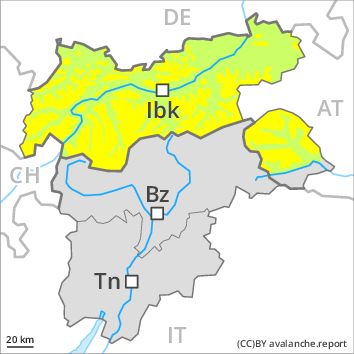Regions
Texel Mountains, Prags Dolomites, Lienzer Dolomites, Sexten Dolomites, Ortler Range, Southern Stubai Alps, Ulten Valley

Danger level
Danger Level 3 - Considerable above the treeline
Danger Level 2 - Moderate above the treeline
Avalanche Problem
Wind-drifted snow above the treeline, N-NE-E-SE-S-SW-W-NW

A sometimes critical avalanche situation will be encountered in some regions.
As a consequence of fresh snow and a strong northerly wind, avalanche prone wind slabs formed, in particular in gullies and bowls, and behind abrupt changes in the terrain at high altitudes and in high Alpine regions in all aspects. Even single winter sport participants can release avalanches, including large ones. In addition a certain danger of moist loose snow avalanches exists. This applies in particular on sunny slopes in steep rocky terrain.
Restraint is advisable on this first sunny day.
Snowpack
dp 6: cold, loose snow and wind
Over a wide area 20 to 40 cm of snow, and even more in some localities, fell. The sometimes strong wind has transported a lot of snow. The fresh snow and wind slabs are lying on soft layers in all aspects. The snowpack will be subject to considerable local variations. Large-grained weak layers exist in the old snowpack in particular on steep shady slopes.
Tendency
Slight decrease in avalanche danger.
Regions
Prealps, Cembra Valley, Bondone and Stivo, Vallarsa, Western Nonsberg Alps, Folgaria - Laverone, Ledro Valley, Latemar

Danger level
Danger Level 3 - Considerable above the treeline
Danger Level 2 - Moderate above the treeline
Avalanche Problem
Wind-drifted snow above the treeline, N-NE-E-SE-S-SW-W-NW

As a consequence of fresh snow and wind a critical avalanche situation will be encountered in some regions.
Wind slabs: As a consequence of fresh snow and a strong northerly wind, avalanche prone wind slabs will form above the tree line, in particular in gullies and bowls, and behind abrupt changes in the terrain at high altitudes and in high Alpine regions in all aspects. Even single winter sport participants can release avalanches easily, including large ones. Backcountry snowshoe touring also calls for extensive experience in the assessment of avalanche danger and careful route selection. A few natural avalanches are to be expected, in the regions exposed to a lot of wind in particular in the regions exposed to heavier precipitation and.
Snowpack
dp 6: cold, loose snow and wind
Over a wide area 30 to 50 cm of snow, and even more in some localities, fell, especially in the Dolomites. The sometimes strong wind will transport the fresh snow. The snowpack will be subject to considerable local variations.
Tendency
Slight decrease in avalanche danger as a consequence of the ceasing of precipitation.
Regions
Eastern Pfunderer Mountains, Durreck Range, Western Rieserferner Mountains, Val Müstair Alps, Western Deferegger Alps, Langtaufers, Schnals Ridge, Southern Zillertal Alps and High Tauern, Eastern Nonsberger Alps, Northern Dolomites of Fiemme, Saldurn-Mastaun Ridge, Gröden Dolomites, Sarntal Alps, Western Pfunderer Mountains

Danger level
Danger Level 3 - Considerable above 2200m
Danger Level 2 - Moderate above 2200m
Avalanche Problem
Wind-drifted snow above 2200m, N-NE-E-SE-S-SW-W-NW

A sometimes critical avalanche situation will persist in some regions.
As a consequence of fresh snow and a strong northerly wind, avalanche prone wind slabs formed at high altitudes and in high Alpine regions. This applies in particular in gullies and bowls, and behind abrupt changes in the terrain in all aspects. Single winter sport participants can release avalanches. Mostly these are medium-sized. In addition a certain danger of moist loose snow avalanches exists. This applies in particular on sunny slopes in steep rocky terrain. Restraint is advisable on this first sunny day.
Snowpack
dp 6: cold, loose snow and wind
Over a wide area 15 to 30 cm of snow, and even more in some localities, fell, in particular along the border with Trentino and along the border with Veneto. The sometimes strong wind has transported a lot of snow. Large-grained weak layers exist in the old snowpack in particular on steep shady slopes. The snowpack will be subject to considerable local variations.
Tendency
Slight decrease in avalanche danger.
Regions
Southern Adamello, Primiero - Pale di S. Martino, Adamello - Presanella, Northern Brenta - Peller, Southern Brenta, Fassa Valley, Sole, Pejo and Rabbi, Southern Lagorai, Northern Lagorai, Maddalene, Paganella, Marzola - Valsugana, Pine' - Mocheni Valley

Danger level
Danger Level 3 - Considerable above the treeline
Danger Level 2 - Moderate above the treeline
Avalanche Problem
Wind-drifted snow above the treeline, N-NE-E-SE-S-SW-W-NW

As a consequence of fresh snow and wind a critical avalanche situation will be encountered in some regions.
Wind slabs: As a consequence of fresh snow and a strong northerly wind, avalanche prone wind slabs will form above the tree line, in particular in gullies and bowls, and behind abrupt changes in the terrain at high altitudes and in high Alpine regions in all aspects. Even single winter sport participants can release avalanches easily, including large ones. Backcountry touring and other off-piste activities call for extensive experience in the assessment of avalanche danger and careful route selection. A few natural avalanches are to be expected, in the regions exposed to a lot of wind in particular in the regions exposed to heavier precipitation and.
Gliding avalanches: In the regions exposed to heavier precipitation there will be a gradual increase in the danger of gliding avalanches, in particular on steep south facing slopes below approximately 2000 m.
Snowpack
dp 6: cold, loose snow and wind
Over a wide area 30 to 60 cm of snow, and up to 70 cm in some localities, fell. The sometimes strong wind will transport the fresh snow. The fresh snow and wind slabs will be deposited on soft layers in all aspects. The snowpack will be subject to considerable local variations. Individual weak layers exist in the old snowpack in particular on steep shady slopes.
Tendency
Slight decrease in avalanche danger as a consequence of the ceasing of precipitation.
Regions
Western Verwall Mountains, Eastern Verwall Mountains, Silvretta, Samnaun Mountains, Northern Oetz and Stubai Alps, Western Tuxer Alps, Eastern Tuxer Alps, Western Kitzbühel Alps, Eastern Kitzbühel Alps, Glockturm Range, Weißkugel Range, Gurgler Range, Central Stubai Alps, Northern Zillertal Alps, Allgäu Alps, Venediger Range, Eastern Lechtal Alps - Ammergau Alps, Mieming Mountains, Eastern Rieserferner Mountains, Karwendel Mountains, Glockner Range, Eastern Deferegger Alps, Brandenberg Alps, Wilder Kaiser Mountains - Waidring Alps, Schober Mountains, Western Lechtal Alps, Central Lechtal Alps, Grieskogel Mountains

Danger level
Danger Level 2 - Moderate above 2200m
Danger Level 1 - Low above 2200m
Avalanche Problem
Wind-drifted snow above 2200m, N-NE-NW

Wind slabs require caution.
As a consequence of fresh snow and a moderate to strong northwesterly wind, sometimes avalanche prone wind slabs formed at high altitudes and in high Alpine regions. They can be released even by a single winter sport participant in particular on steep shady slopes. The avalanche prone locations are to be found in particular adjacent to ridgelines and in gullies and bowls in northwest to north to northeast facing aspects. At elevated altitudes the avalanche prone locations are more prevalent. In the regions neighbouring those that are subject to danger level 3 (considerable) and in the regions exposed to heavier precipitation the avalanche danger is higher.
In addition there is a danger of moist loose snow avalanches. This applies in particular on very steep sunny slopes.
Snowpack
dp 6: cold, loose snow and wind
dp 9: graupel blanketed with snow
The snowpack will be subject to considerable local variations. Over a wide area 10 to 20 cm of snow, and even more in some localities, fell above approximately 1000 m. The sometimes strong wind has transported the fresh snow. The wind slabs of yesterday have settled a little.
Tendency
Gradual decrease in avalanche danger.





